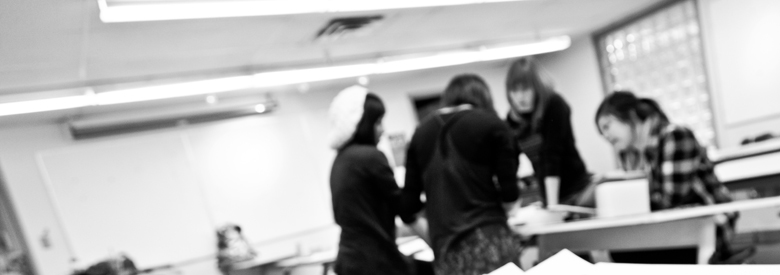Candidate Information
This physical aptitude evaluation protocol was developed by the Work Physiology Laboratory at the University of Alberta and is administered by the Department of Kinesiology at Langara College. Please read the following information carefully to prepare for your test.
For questions about the test, please send an email to firetest@langara.ca.
Location
Testing will be completed in the Kinesiology Laboratory (Room T515 of the Science & Technology Building), on the main campus of Langara College (100 W 49th Ave, Vancouver). Parking is available in the parkade under the Library Building or in surface lots around the campus. Maps of the campus and the Science & Technology Building can be found here:
Results
You will be provided with a copy of your personal results when you finish the tests. Your results will also be forwarded directly to the relevant fire department(s).
Have a light, healthy meal at least two hours before your test. If your appointment is first thing in the morning, do not skip breakfast. Try not to eat within two hours of the start of your test.
Avoid alcoholic beverages and cannabis products the day before and definitely on the day of your test. Do not smoke or vape for at least two hours before your test. Avoid caffeine for at least two hours before your test, especially if consuming caffeine is not a part of your usual daily nutritional routine.
Avoid exercise at intensities that are higher than you are accustomed to for at least two days prior to your test. Even if you are accustomed to regular high-intensity exercise, limit yourself to only moderate- or light-intensity exercise for at least two days prior to your test.
Try to sleep well for several nights leading up to your test, and do your best to reduce your sources daily of stress. You will perform your best if you are well nourished, well hydrated, well rested, relaxed, and focused.
Before you will be allowed to begin your test, you must have submitted a Medical Clearance Form, signed by your physician. This will help the testing team to determine that it is safe for you to participate in the test. It is your responsibility to ensure that all parts of the form are completed correctly. You will not be allowed to proceed with the test unless this form is completed correctly. You may submit your completed form to firetest@langara.ca.
Identification
Government-issued photo identification (e.g. drivers licence) must be presented upon your arrival at the Kinesiology Laboratory in order to verify your identity. You will not be allowed to proceed with the test without suitable identification.
Clothing
Bring the following items of clothing with you: shorts, two T-shirts, running shoes, extra socks, and sweatpants, and a sweatshirt. Your T-shirt will be wet from sweat after the treadmill test. You should change into a dry shirt and then put on your sweatpants and sweatshirt to keep warm during the 60-minute rest period before your job-related tests. We will provide you with fire protective ensemble for the testing session, including boots. While we have a wide selection of firefighting boots, getting an exact fit may not always be possible. To get the best fit, please bring several pairs of socks (thin and thick sport socks).
Towel
You may use the shower facilities at Langara after your test. If you plan to use the showers, please bring your own towel.
Water and Snacks
You should bring a water bottle or sports drink (e.g., Gatorade). Avoid “energy drinks” like Red Bull or Monster Energy.
You may want to eat a small snack (e.g., a banana or a Power Bar) during the rest period between the treadmill test and the job-related tests. Eat only foods that you are accustomed to eating for recovery from exercise. Do not try any foods or drinks for the first time during your test. You should know how your body reacts to your nutritional plan well in advance of your test.
Try to practice your nutritional plan in advance of your test so that you know how much to eat and drink during three or more hours of intermittent, high-intensity exercise under conditions of heat stress. If you eat or drink too much, you might feel sick. If you eat and drink too little, you might feel under-fueled or become dehydrated.
Optimal nutrition and hydration strategies tend to be very individual. Work this out for yourself. Don’t follow someone else’s advice unless you have had the chance to make sure it works for you under the kind of conditions you will experience during these tests.
This testing protocol is designed to evaluate the physical work capacities of healthy, physically active individuals. Each test requires a maximal effort. You must pass all of the tests to successfully complete the overall evaluation.
All of the tests must be completed while wearing firefighting personal protective equipment (PPE), which will be provided when you arrive for your testing. The PPE includes a helmet, a flash hood, coveralls, pants, a jacket, boots, leather work gloves, and a self-contained breathing apparatus (SCBA). The PPE weighs approximately 23 kg (51 lb), depending on size. You will not breathe from the SCBA, but you must carry it throughout the tests. For safety during the treadmill test, running shoes are substituted for firefighting boots.
Aerobic Endurance Treadmill Test
Peak oxygen uptake (VO2 peak) will be measured during a progressive, incremental exercise test to exhaustion on a treadmill.
After a standardized 5-minute warm-up, you will walk at a speed of 3.5 mph and 10% grade for 8 minutes. This is referred to as the constant work rate phase.
Once the constant work rate phase is completed, you will immediately progress to the incremental phase. During this phase, the treadmill speed remains at 3.5 mph but the grade increases by 1% every minute to a maximum of 15%. Subsequently, the speed will increase by 0.5 mph every minute while the grade remains at 15% until you can no longer continue.
The total duration of this test depends on your fitness level and motivation, but usually lasts about 16 minutes. Generally, the longer the duration of the test, the better the VO2 peak score. Aerobic endurance will be evaluated from two test outcomes: total time on the treadmill and, your VO2 peak score.
When the incremental phase is completed, there is a mandatory 5-min cool-down (slow walk on a flat treadmill). To pass the treadmill test, you MUST complete the 5-min warm-up, the 8-min constant work rate phase and the 5-minute cool-down (for a total of at least 18 minutes). You are encouraged to continue for as long as you are able to.
During the treadmill test, expired gases are monitored with a metabolic measurement system to calculate your rate of oxygen consumption. Heart rate is also monitored continuously throughout the test.
Orientation to Job-Related Tests
After the treadmill test, there is a 60-minute rest period before the start of an orientation to the job-related tests. The orientation to the job-related tests is standardized and must be completed according to the instructions of the testing staff.
Equipment Carry / Vehicle Extrication
 You will lift and carry small (20 kg or 44 lb) and large (36 kg or 80 lb) vehicle extrication tools (the “Jaws of Life”) from the starting point and place them in designated places on the floor 15 m (50’) away.
You will lift and carry small (20 kg or 44 lb) and large (36 kg or 80 lb) vehicle extrication tools (the “Jaws of Life”) from the starting point and place them in designated places on the floor 15 m (50’) away.
Next, you will pick up the smaller (20 kg) tool, carry it 7.6 m (25’), and set it down in front of a vehicle door mock-up.
The smaller tool must then be held in a level position at right angles to the door mock-up with the “jaws” in firm contact with each of three flat metal discs that are similarly oriented to the three “pins” that must be broken to remove a car door. The tool must be held in the correct position for 30 s on each disc. The tool is set down between each hold, and you must stand erect before lifting the tool and moving on to the next point of contact.
After this sequence is completed, you will return both tools to the starting point. The total walking distance is 105 m (345’).
This test evaluates the muscular strength and endurance required to lift, carry, and use heavy tools in rescue situations. To pass the test, you must complete all aspects of the simulation safely and with correct form in 225 seconds or less.
Charged Hose Advance
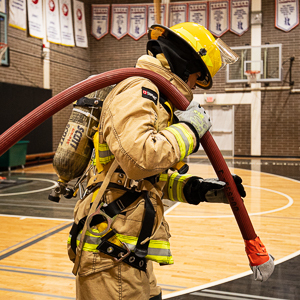 From a standing position facing forward, you will bend and pick up a nozzle connected to 3 lengths of charged 44 mm (1.75”) hose. The test time starts when you move to pick up the hose. Holding the nozzle and hose securely with two hands over your preferred shoulder, you will advance the hose to the finish line.
From a standing position facing forward, you will bend and pick up a nozzle connected to 3 lengths of charged 44 mm (1.75”) hose. The test time starts when you move to pick up the hose. Holding the nozzle and hose securely with two hands over your preferred shoulder, you will advance the hose to the finish line.
The hose must be advanced a distance of 30 m (100’) while walking as quickly as possible (running is not permitted). The test time stops when you place both feet securely on a rubber mat.
This test assesses lower body strength and power for pulling and dragging. The test must be completed correctly and safely in 27 seconds or less.
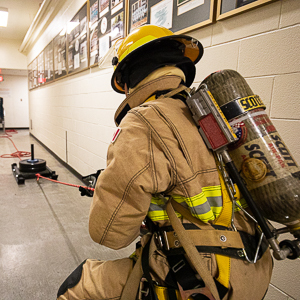
Starting from a standing position, you will bend and pick up a length of static 16 mm (5/8”) nylon rope attached to a weighted sled. The test time begins when you begin to reach for the rope.
Keeping your feet securely in place, you will use the rope to pull the sled over the floor a distance of 15.24 m (50’). You will then walk 15.24 m (50’) and repeat the pull. You will then walk back 15.24 m (50’) and repeat the pull for a third time. The test time stops when the sled has completely crossed the line for the third time.
This test assesses upper body strength, power, and endurance for pulling and hoisting. The test must be completed correctly and safely in 110 seconds or less.
Forcible Entry Simulation
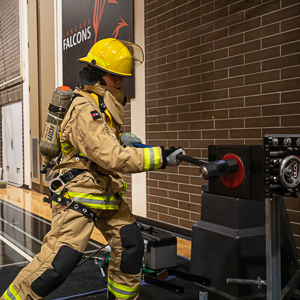 Starting from a standing position, you will pick up a 4.5 kg (10 lb) sledgehammer and use it to strike the mechanically braked target surface of a forcible entry apparatus.
Starting from a standing position, you will pick up a 4.5 kg (10 lb) sledgehammer and use it to strike the mechanically braked target surface of a forcible entry apparatus.
The test clock starts as soon as you reach for the hammer which is standing on the floor
directly in front of the apparatus, and stops as soon as a buzzer goes off, indicating the end of the test.
This test assesses muscle strength and power for striking. The test must be completed correctly and safely in 19 seconds or less.
Victim Rescue
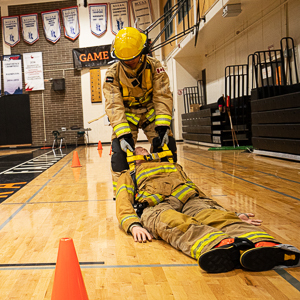
Starting from a standing position, you will bend to grasp a mannequin weighing approximately 83 kg (183 lb) by the handles of a rescue harness and drag it through a 15 m serpentine obstacle course.
You will continue to drag the mannequin around a traffic cone at the end of the obstacle course, and then return through the obstacle course to the start line, for a total distance of 30 m (100').
The test clock starts when you move to pick up the mannequin and ends when the mannequin’s feet are completely across the finish line. No part of your body or the mannequin may touch the traffic cones during the test.
This test assesses upper and lower body muscle strength and endurance for pulling and dragging. The test must be completed correctly and safely in 57 seconds or less.
Ladder Climb
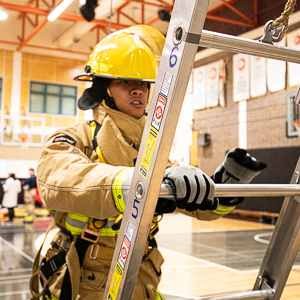 Starting from a standing position, you will climb 10 rungs (3.45 m) up and down a 7.2 m (24’) ladder. This is repeated 5 times as quickly as possible.
Starting from a standing position, you will climb 10 rungs (3.45 m) up and down a 7.2 m (24’) ladder. This is repeated 5 times as quickly as possible.
A repetition begins with both feet on the floor at the base of the ladder. You will climb and place two feet on the 10th rung (a weight bearing step is required on the 10th rung), reverse direction, and climb down until both feet are again on the floor to complete the repetition.
The test clock starts when you move to start climbing the first rung and ends when both feet are on the floor after the 5th repetition.
You must always maintain three points of contact on the ladder, and must climb the ladder one rung at a time, without skipping any of the rungs. The test must be completed correctly and safely in 97 seconds or less.
This test evaluates the leg strength and endurance required for climbing under load.
